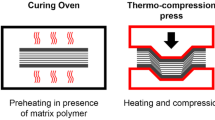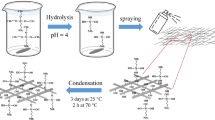The article presents the results of experimental studies on the effects of the electrophysical processing of a polymer binder directly in a mold on the mechanical characteristics of glass fiber-reinforced plastic. The results of the supramolecular structure studies and the polymer binder’s thermophysical properties are presented. Finally, the physical interpretation of the results is also presented.
Similar content being viewed by others
Explore related subjects
Discover the latest articles, news and stories from top researchers in related subjects.Avoid common mistakes on your manuscript.
In the manufacture of products from polymer composite materials, obtaining materials with enhanced mechanical and physical properties is the most important scientific and practical task. One of the ways to solve this problem is the modification of a polymer binder using various methods [1,2,3]. For example, Ref. [4] substantiated the use of preliminary electrophysical treatment of a polymer binder by electromagnetic pulses and waves. They experimentally confirmed the efficiency of this approach based on the results of studies of the mechanical properties of fiberglass. They also achieved an increase in the strength of products from fiberglass Etal T 210-T11-GVS9 by 1.4–1.7 times with the preliminary electrophysical treatment of the epoxy binder via the combined effect of nanosecond electromagnetic pulses (NEMP) and electromagnetic alternating field (EMF) for 25 min. In the current work, another variant of the electrophysical modification of an epoxy binder is investigated, that is, increasing the strength of fiberglass via direct electropulse processing of the binder during the product molding process.
Studies on the Mechanical Properties of Fiberglass
The experimental study aimed to establish the dependence of the mechanical properties of fiberglass on the duration of the epoxy binder’s electropulse processing (during product molding), as well as to evaluate the efficiency of such a technical solution compared with the binder’s preliminary electropulse processing.
In contrast to previous studies [4], the electric pulse treatment of the epoxy binder in the current study was performed directly in the mold during the manufacture of a fiberglass blade of a centrifugal compressor unit’s impeller. The layout of the experimental unit is presented in Fig. 1. The nomenclature of controlled properties, the materials under study, the method of obtaining samples, the equipment, and the parameters of the electro- pulse processing of the binder were the same as those used in a previous work [4].
The experimental data for assessing the relationship between the type and duration of the electropulse processing of the epoxy binder Etal T 210 are shown in Fig. 2, along with the mechanical characteristics of the Etal T 210-T11-GVS9 fiberglass samples. In accordance with the results of data analysis, we found that the joint processing of the NEMP and EMF of the epoxy binder directly in the mold (Figs. 2a and 2b, curve 1) increased the strength of the finished fiberglass. At the same time, higher values of the material’s mechanical properties were established compared with the basic values and those obtained during the individual processing of the NEMP (Figs. 2a and 2b, curve 3) and EMF (Figs. 2a and 2b, curve 4) binders. The values of the mechanical characteristics of fiberglass were also maximized after the joint treatment of the polymer binder with NEMP and EMF for 25 min.
Dependences of the strength of fiberglass in tension σt, in static bending σb on the duration of the binder processing: 1 – processing of the binder with NEMP and EMF directly in the mold; 2 – preliminary (before molding) processing of the binder with NEMP and EMF; 3 – processing of the binder with NEMP during molding; 4 – processing of the binder with EMF during molding.
A comparative analysis of the efficiencies of processing the epoxy binder during product molding was conducted by referring to the data in Figs. 2a and 2b (curve 2), which show the effects of the joint treatment of the binder with NEMP and EMF before molding. Such data were obtained from an earlier work [4]. Based on a comparison of the data presented, we found that the electropulse processing of an epoxy binder directly in the mold helped improve the technology for manufacturing products from polymer composite materials. When implementing this approach, higher strength indicators of the material are provided, along with a continuous mode of molding parts and products, thereby increasing the productivity of the technological process as a whole.
Microstructural Studies
Using a JSM-6480 scanning electron microscope (SEM) from JEOL (Japan), microstructural studies of samples of the cured epoxy binder were performed to determine the nature of the change in the polymer’s supramolecular structure after electropulse joint processing of the binder by NEMP and EMF. The results are presented in Fig. 3.
As can be seen, the supramolecular structure of the epoxy binder without electropulse treatment (Fig. 3a) consisted of spherulites with a pronounced anisotropy, whereas interspherulite boundaries were clearly manifested as regions enriched in low molecular weight fractions, impurities, chain ends, and defects [5]. When implementing the preliminary electropulse treatment of the binder in the liquid state with NEMP and EMF [4] (Fig. 3b), the polymer’ supramolecular structure was also spherulitic with pronounced anisotropy. However, the spherulites were smaller, and a tendency to transition from a spherulitic to a fibrillar structure was observed. The supramolecular structure of the binder after joint treatment with NEMP and EMF during molding (Fig. 3c) showed a continuous fibrillar structure with minimal anisotropy of polymer chains and packs (of which fibrils are composed). Furthermore, the reorientation of spherulites into fibrils was observed during the electric pulse treatment of the epoxy binder for 25 min directly in the mold (with the combined action of NEMP and EMF during molding).
Study of the Thermophysical Properties of the Binder
To confirm the data on the change in the supramolecular structure of the binder after joint electropulse processing with NEMP and EMF, the thermophysical properties of cured epoxy binder samples were studied on a Netzsch LFA-457 unit (Germany). The operating principle was based on the laser flash method. During the laser flash measurements, the lower surface of the sample was heated using a short laser pulse, and the corresponding change in the temperature of the upper surface of the sample was recorded by an infrared detector. Thus, we determined the temperature conductivity of the sample (i.e., the higher the temperature conductivity, the greater the signal strength).
“Temperature conductivity” refers to the rate of change (equalization) of the temperature of a substance in nonequilibrium thermal processes [6]. In addition, temperature conductivity and thermal conductivity are highly sensitive indicators of structural changes in solids [6, 7]. Thus, temperature conductivity data are required to determine the thermal conductivity of a sample. In the current study, the given values of thermal conductivity were calculated automatically by the device, based on the obtained values of temperature conductivity.
Table 1 presents the values of the thermophysical parameters of the epoxy binder for various options for joint electropulse processing with NEMP and EMF. As can be seen, the combined treatment of the epoxy binder with NEMP and EMF for 25 mins increased the values of the studied thermophysical parameters compared with those of the untreated binder. This finding demonstrates a higher homogeneity degree of the treated binder’s supramolecular structure compared with the untreated binder. This finding is also confirmed by the results of microstructural studies shown in Fig. 3.
Conclusions
In this study, we experimentally established that the electric pulse treatment of the epoxy binder with NEMP and an electromagnetic alternating field directly in the mold during molding resulted in a fiberglass with increased (by 15%) strength properties compared with the pretreatment of the binder before product molding. In addition, by applying electropulse processing during molding, the technological process for the production of parts and products from fiberglass can be performed continuously, thus increasing the productivity as a whole.
SEM results revealed the transformation of the supramolecular structure of the epoxy binder from spherulitic to fibrillar after joint binder treatment with NEMP and an electromagnetic field. In addition, the most homogeneous supramolecular structure is formed during the implementation of electropulse processing directly in the mold during product molding. This finding is confirmed by the results obtained after studying the binder structure via SEM and measuring the mechanical properties of the resulting fiberglass.
This research was conducted at the Center for Collective Use “Applied Materials Science” of the Pacific National University, with the financial support of the Ministry of Science and Education of the Russian Federation under Research Work No. FEME-2023-0009.
References
V. N. Kuleznev and V. A. Shershnev, Chemistry and Physics of Polymers [in Russian], KolosS, Moscow (2007).
Yu. V. Zelenev and V. I. Khromov, “Predicting changes in the physical properties of polymeric materials with different methods of their modification,” Plastich. Massy, No. 11, 11–13 (2002).
V. N. Kestelman and A. D. Stadnik, Thermomagnetic Treatment of Polymer Composite Materials [in Russian], NII TEHIM, Moscow (1989).
O. Yu. Erenkov, V. L. Nikishechkin, and V. P. Igumnov, “Study of the mechanical properties of polymer composite materials,” Vest. Mashinostr., No. 4, 61–63 (2010).
A. A. Askadsky, Deformation of Polymers [in Russian], Khimiya, Moscow (1973).
L. N. Novichenok and Z. P. Shulman, Thermophysical Properties of Polymers [in Russian], Nauka i Tekhnika, Minsk (1971).
S. B. Aybinder and N. G. Andreeva, “Influence of fillers on thermophysical, mechanical, and antifriction properties of polymers,” Izv. AN Lat. SSR, Ser. Fiz. Tekhn. Nauk, No. 5, 3–18 (1983).
Author information
Authors and Affiliations
Corresponding author
Additional information
Translated from Khimicheskoe i Neftegazovoe Mashinostroenie, Vol. 59, No. 3, pp. 35−37, March, 2023.
Rights and permissions
Springer Nature or its licensor (e.g. a society or other partner) holds exclusive rights to this article under a publishing agreement with the author(s) or other rightsholder(s); author self-archiving of the accepted manuscript version of this article is solely governed by the terms of such publishing agreement and applicable law.
About this article
Cite this article
Erenkov, O.Y., Yavorskiy, D.O. Improving Fiberglass Strength Using the Electropulse Treatment of Epoxy Binder in the Product Molding Process. Chem Petrol Eng 59, 240–244 (2023). https://doi.org/10.1007/s10556-023-01234-0
Published:
Issue Date:
DOI: https://doi.org/10.1007/s10556-023-01234-0







